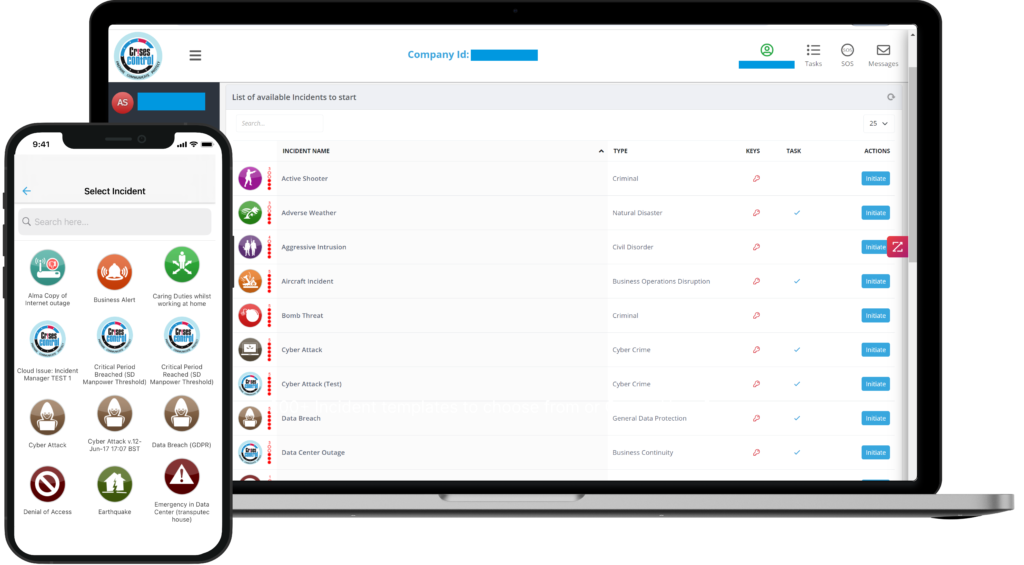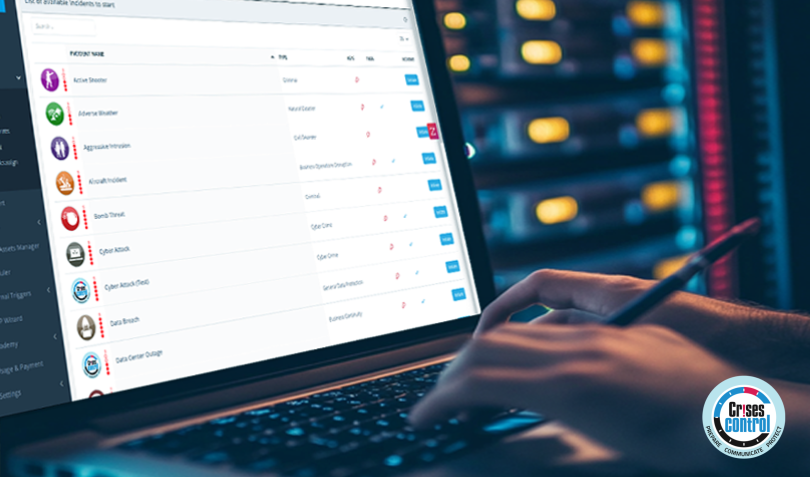Written by Anneri Fourie | Marketing Executive
In the high-stakes world of crisis management, human error is a silent but pervasive threat. It’s the kind of risk that can derail even the most well-prepared response plans, leading to costly mistakes, prolonged downtime, and, in some cases, catastrophic outcomes. While human error can never be entirely eliminated, it can be significantly mitigated. This is where business continuity software comes into play.
Business continuity software provides organisations with the tools they need to minimise human error during a crisis. By automating protocols, centralising communication, and providing real-time data, this software ensures that teams can respond swiftly and accurately, even under the most challenging conditions.
In this blog, we’ll explore the various facets of human error in crisis management and demonstrate how Crises Control’s business continuity software can help safeguard your organisation from these risks.
Understanding Human Error in Crisis Management
Human error is an unavoidable aspect of any operation, but its impact is magnified during a crisis. Under the pressure of time-sensitive decisions, incomplete information, and the stress of the situation, even the most experienced teams can falter. Let’s delve into some common types of human errors that can occur during a crisis:
Decision-Making Errors
Under stress, people are more likely to make poor decisions. This could be due to cognitive overload, where too much information is processed at once, or due to stress-induced panic, leading to snap judgments without full consideration of the consequences.
Communication Breakdowns
Miscommunication or lack of communication can lead to significant errors. In a crisis, clear, timely, and accurate communication is crucial. However, stress and urgency often result in incomplete, misunderstood, or delayed messages.
Procedural Mistakes
Crises often require quick action according to predefined protocols. However, in the heat of the moment, critical steps can be skipped, incorrect procedures can be followed, or protocols may be misinterpreted.
These errors are not just theoretical risks; they have real-world implications. History is filled with examples of crises that were exacerbated by human error—whether it’s a delayed response due to miscommunication or a misjudged decision that led to escalated consequences.
How Business Continuity Software Mitigates Human Error
While human error cannot be entirely eradicated, its impact can be significantly reduced with the right tools and processes. Business continuity software, like Crises Control, plays a crucial role in this by providing clear, automated protocols and facilitating seamless communication and decision-making during crises.
Automated Protocols: Guiding Your Team Step by Step
One of the key features of business continuity software is the ability to automate crisis management protocols. These are pre-defined, step-by-step procedures that are triggered automatically during a crisis.
- Standardised Response: Automated protocols ensure that every team member follows the same steps, reducing the likelihood of critical actions being missed or executed incorrectly. This standardisation is vital in ensuring a consistent and effective response.
- Real-Time Guidance: Crises Control’s business continuity software provides real-time guidance, directing teams through each step of the process. This reduces the cognitive load on individuals and allows them to focus on executing their tasks accurately.
- Scenario-Based Protocols: With Crises Control, organisations can create scenario-specific protocols, ensuring that the response is tailored to the nature of the crisis. This customisation further reduces the potential for error by aligning actions with the specific needs of the situation.
Centralised Communication: Keeping Everyone on the Same Page
Communication is often the first casualty in a crisis. When every second counts, delays, and miscommunications can have severe consequences. Business continuity software addresses this by centralising and streamlining communication across all levels of the organisation.
- Unified Messaging: Crises Control allows for mass notifications to be sent out to all relevant stakeholders simultaneously. This ensures that everyone receives the same message at the same time, reducing the risk of miscommunication.
- Two-Way Communication: In addition to sending out instructions, the software facilitates two-way communication, allowing team members to report back, ask questions, and provide updates. This ensures that the flow of information is constant and reliable.
- Audit Trails: Crises Control maintains a log of all communications, providing an audit trail that can be reviewed later. This feature is particularly useful for post-crisis analysis and helps in identifying areas where communication could be improved.
Real-Time Data and Analytics: Informed Decision-Making
One of the most significant advantages of using business continuity software is the access to real-time data and analytics. In a crisis, having the right information at your fingertips can make all the difference between a successful resolution and a prolonged ordeal.
- Live Dashboards: Crises Control offers live dashboards that provide a real-time overview of the situation. This allows crisis managers to monitor developments as they happen and adjust their strategies accordingly.
- Data-Driven Decisions: The software’s analytics capabilities enable decision-makers to base their actions on accurate, up-to-date information. This reduces the likelihood of errors caused by outdated or incomplete data.
- Predictive Analytics: Some business continuity software, including Crises Control, incorporates predictive analytics to forecast potential developments and suggest proactive measures. This helps in staying ahead of the crisis and mitigating risks before they materialise.
Training and Simulations: Preparing for the Worst
Preparation is key to minimising human error during a crisis. Business continuity software facilitates regular training and simulations, helping teams to familiarise themselves with protocols and refine their response strategies.
- Scenario-Based Training: Crises Control allows organisations to run scenario-based training exercises that mimic real-world crises. This hands-on approach helps teams to practise their response in a controlled environment, building muscle memory and reducing the potential for errors during an actual event.
- Performance Tracking: The software tracks performance during these simulations, providing insights into areas where improvements are needed. This data-driven feedback loop is crucial for continuous improvement and error reduction.
- Crisis Simulations: By regularly running crisis simulations, teams can identify weaknesses in their response plans and address them proactively. This preparedness is essential in ensuring that human error is minimised when a real crisis strikes.

Interested in our Business Continuity Software?
Safeguard your business and reduce downtime and mitigate risk with our crisis management solutions.
Why Choose Crises Control?
Crises Control stands out as a leader in business continuity software, offering a comprehensive suite of tools designed to mitigate human error and enhance crisis management capabilities. Here’s how Crises Control can specifically help your organisation:
- User-Friendly Interface: Crises Control’s intuitive interface ensures that users can navigate the platform quickly and efficiently, even under pressure. This ease of use is crucial in reducing the likelihood of errors during a crisis.
- Customisable Alerts and Protocols: The software allows organisations to create customisable alerts and protocols that align with their specific needs. This flexibility ensures that the response is tailored and effective, reducing the risk of procedural errors.
- Scalable and Reliable: Whether you’re a small business or a large enterprise, Crises Control is scalable to meet your needs. Its robust infrastructure ensures that the software remains reliable and functional, even in the most demanding situations.
- 24/7 Accessibility: Crises Control operates on a cloud-based platform, ensuring that your crisis management tools are accessible anytime, anywhere. This round-the-clock availability is vital in ensuring a timely and effective response.
- Expert Support: Crises Control provides expert support to help organisations set up and optimise their crisis management strategies. This hands-on assistance is invaluable in ensuring that your team is fully prepared to handle any situation.
Conclusion
Human error is an inherent risk in crisis management, but it doesn’t have to be a crippling one. By implementing business continuity software like Crises Control, organisations can significantly reduce the likelihood of errors and enhance their overall crisis management capabilities. From automated protocols and centralised communication to real-time data and rigorous training, Crises Control offers the tools needed to navigate crises with confidence and precision.
Don’t let human error be the weak link in your crisis management strategy. Get a free personalised demo of Crises Control today and see how our business continuity software can safeguard your organisation against the unexpected. Contact us now to learn more.
Request a FREE Demo

